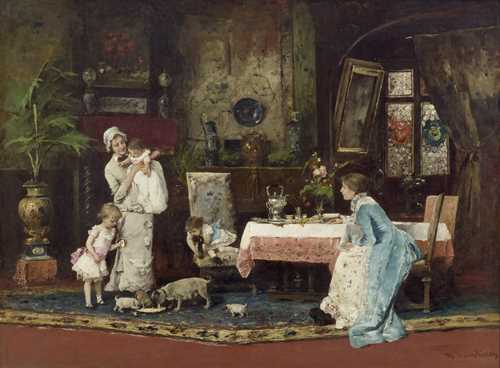
Lot 3231 - A204 19th Century Paintings - Friday, 31. March 2023, 04.00 PM
MIHÁLY VON MUNKÁCSY
[Art.ArtText.Text@@1('[Art.BoId],21')]
[Art.ArtText.Text@@1('[Art.BoId],22')]
[Art.ArtText.Text@@1('[Art.BoId],23')]
[Art.ArtText.Text@@1('[Art.BoId],24')]
[Art.ArtText.Text@@1('[Art.BoId],25')]
Private collection, Switzerland.
Dr Judit Boros confirms that she examined the painting in 2017 and that it is an original work by Mihály Munkácsy. (E-Mail 17.11.2022).
Endowed with exceptional technical skill and especially appreciated for the decorative quality of his paintings, Mihály Munkácsy was one of the most successful and well-known painters of his time. The painting offered here, ‘Two Families’, is one of the most famous and subtly executed works of the so-called ‘Salon Pictures’, a group of works which Munkácsy worked on between 1878 and 1887. The present painting is a scaled-down version of the first rendition of this theme, which was painted around 1880 (Lajos Végvári: Katalog der Gemälde und Zeichnungen Mihály Munkácsys, Budapest 1959, cat. no. 286, p. 53.). Munkácsy had already dealt extensively with the motif of the two families in his early work. At that time, he staged them in a modest kitchen interior, before taking up the motif again a few years later in an updated context and placing the two families in a bourgeois Parisian salon interior. The theme continues to find great favour with collectors today, as demonstrated at a recent auction in Vienna, where a scaled-down version of the kitchen scene fetched many times its estimate.
Just as Munkácsy builds up his palette from dark to light hues, he also carefully composes this depiction of ‘Two Families’ by combining the individual components into an overall narrative: the family of dogs sitting on the carpet in the foreground, the children watching the dogs in fascination, while on the right the lady in blue watches the nurse with the youngest child in her arms. Through these perspectives, relationships are built up between the figures, directing the viewer's attention through the intimate space and across the lavish furnishings, which illustrate the opulence of the Parisian bourgeoisie.
Mihály Munkácsy (née Lieb) met the itinerant painter Elek Szamossy (1826–1888) in the late 1850s and assisted him as a pupil on his travels through Hungary between 1861 and 1862. In 1866 Munkácsy moved to Germany; first to Munich, where many other Hungarian painters had settled, and then on to Düsseldorf, where he studied at the academy under the German genre painter Ludwig Knaus (1829–1910). Knaus taught the young Munkácsy how to use a bitumen ground for his canvases and panels. On this dark ground he built up his compositions with strong impasto brushstrokes and worked his way up, tone by tone, to lighter colour accents. This is a remarkable technique which lends Munkácsy's works a characteristic warmth. During his time at the Düsseldorf Academy, Munkácsy painted ‘The Last Day of a Condemned Man’, a painting which made the artist famous overnight at the age of just 26 and won him the gold medal at the Paris Salon in 1870.
A year later, Munkácsy settled in Paris, where his art was strongly influenced by the realism of Gustave Courbet (1819–1877) and the Barbizon school. During this period, his art is characterised by a dark and sombre tonality that reflects the reverberations of the Franco-Prussian War. However, his marriage to the Baroness de Marches, the widow of his late Luxembourg patron, in 1874, led to a striking artistic transformation. With his newfound fortune, Munkácsy turned from his emotionally charged depictions of the lower classes with their social critique, to an idealised environment of elegance and wealth. Like the interiors in his paintings, he now lived in an impressive townhouse on the Avenue de Villier with one of the most elegant salons in Paris, where he hosted glamorous soirées for the most renowned members of the Paris art scene.
CHF 100 000 / 150 000 | (€ 103 090 / 154 640)
Sold for CHF 402 900 (including buyer’s premium)
All information is subject to change.

